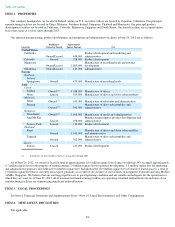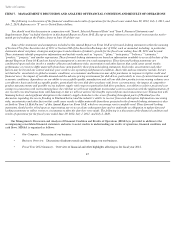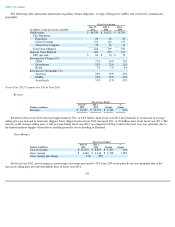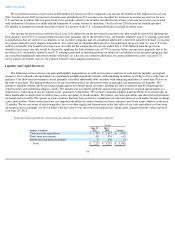Seagate 2011 Annual Report Download - page 51
Download and view the complete annual report
Please find page 51 of the 2011 Seagate annual report below. You can navigate through the pages in the report by either clicking on the pages listed below, or by using the keyword search tool below to find specific information within the annual report.
Table of Contents
657 million units during fiscal year 2011. As of June 29, 2012, we believe that the HDD industry's component supply chain has substantially
recovered.
Demand Trends for Disk Drives.
We believe that continued growth in digital content requires increasingly higher storage capacity in order to store, aggregate, host,
distribute, manage, backup and use such content, which we believe will continue to result in increased demand for disk drive products. In
addition, we believe the continued increased demand for electronic data storage, in developed countries as well as in emerging economies,
reflects the demand for real-time access to rich data and content driven by the impact of a highly mobile and increasingly connected user base.
We believe these trends will continue as computing architectures evolve to serve the growing commercial and consumer user base throughout
the world.
We believe that in the foreseeable future the traditional enterprise and client compute markets that require high capacity storage solutions,
as well as the data intensive client non-compute markets, will continue to be best served by hard disk drives based on the industry's ability to
deliver cost effective, reliable and energy efficient mass storage devices. Furthermore, the increased use of client non-compute devices that
consume media rich content streamed from the cloud increases the demand for high capacity disk drives in nearline applications.
Price Erosion. Our industry has been characterized by price declines for disk drive products with comparable capacity, performance and
feature sets ("like-for-like products"). Price declines for like-for-like products ("price erosion") are more pronounced during periods of:
•
economic contraction or industry consolidation in which competitors may use discounted pricing to attempt to maintain or gain
market share;
• few new product introductions when competitors have comparable or alternative product offerings; and
•
industry supply exceeding demand.
Disk drive manufacturers typically attempt to offset price erosion with an improved mix of disk drive products characterized by higher
capacity, better performance and additional feature sets and/or product cost reductions.
Seasonality
The disk drive industry traditionally experiences seasonal variability in demand with higher levels of demand in the second half of the
calendar year. This seasonality is driven by consumer spending in the back-to-school season from late summer to fall and the traditional holiday
shopping season from fall to winter. In addition, corporate demand is typically higher during the second half of the calendar year.
Fiscal Year 2012 Summary
Revenues for fiscal year 2012 were $14.9 billion which represented a 36% increase in revenues from $11.0 billion in the prior fiscal year.
Gross margin as a percentage of revenue increased to 31% from 20% in the prior fiscal year.
Transaction with Samsung
On December 19, 2011, we completed the acquisition of Samsung's HDD business pursuant to an asset purchase agreement ("APA")
entered into on April 19, 2011, by which the Company acquired certain assets and liabilities of Samsung relating to the research and
development, manufacture and sale of HDDs. The transaction and related agreements are expected to improve our position as a supplier of 2.5-
inch products; position us to better address rapidly evolving opportunities in markets including, but not limited
47
























